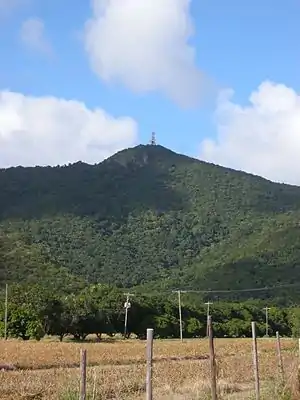Liste der Important Bird Areas in Antigua und Barbuda
Important Bird Areas (IBA) wurden von BirdLife International als besonders wertvolle Lebensräume für Vögel festgestellt. Sie stellen keine Schutzkategorie mit rechtlichen Folgen im eigentlichen Sinn dar, sondern weisen auf einem Schutzbedarf hin. Eine weitere Auszeichnung sind Endemic Bird Areas (EBA) für endemische Tierarten.

In Antigua und Barbuda sind 12 Important Bird Areas ausgewiesen, mit knapp 200 km², die etwa 1⁄5 der Landesfläche umfassen. Außerdem gehört das ganze Land zu einem großen Endemic Bird Area, einem vom sechs in der Karibik, die als Hotspot der Biodiversität gilt.[1][2]
Antigua und Barbuda hat die Cartagena-Konvention (1983/1986) unterzeichnet,[3] die die Unterzeichnerstaaten zum Schutz mariner Ökosysteme verpflichtet, und 1990 das SPAW-Protokoll (Specially Protected Areas and Wildlife in the Wider Caribbean Region) der UNEP,[3] in dem für Meeresschutzgebiete die Zusammenarbeit auch mit BirdLife gefordert wird.[4] Es stehen inzwischen etwa 2⁄3 der ausgewiesenen IBA-Fläche unter einem nationalen Schutz, wenn auch sehr unterschiedlich streng.
Liste der IBAs und EBAs in Antigua und Barbuda
- Lage … Parish/Dependency; und Koordinate(G.)
- Krit. … IBA criteria, Auswahlkriterien der zu finden Vogelarten (A1 ... weltweit bedroht, A2 ... endemisch, A4/B4 ... Sammlungsgebiet)[5]
| Nr. | Bezeichnung | Lage (G.) | ha (Fl.) | Höhe m ü.m. | Krit. | seit | Anmerkungen (Sort.) |
|---|---|---|---|---|---|---|---|
| AG001 | Redonda  |
Redonda |
720 | 0–296 | B4ii | 2007 | ganze Insel (56 ha) mit umliegendem Meeresgebiet |
| AG002 | Codrington Lagoon and the Creek | Barbuda |
7.785 | 0–7 | A1, A2, A4i, A4ii | 2007 | mit vorgelagerten Riffen; darin auch Codrington Lagoon RS (Nr. 1488, 36 km²), großteils Codrington Lagoon NP (CLNP, 67 km²) |
| AG003 | McKinnons Salt Pond | St. John |
78 | 0–2 | A1, A4i, B4i | 2007 | |
| AG004 | Hanson’s Bay–Flashes | St. Mary |
185 | o.A. | A1, A4i | 2007 | |
| AG005 | Valley Church Bay | St. John, St. Mary |
20 | 0–10 | A1, A2, B4i | 2007 | |
| AG006 | Offshore Islands  |
St. John, St. Mary |
9.021 | 0–50 | A1, A2, B4i | 2007 | zwei Teilgebiete an Ost- und Westküste, Ostteil im Rahmen des North East Marine Management Area (NEMMA, 78 km²) geschützt |
| AG007 | Fitches Creek Bay(–Parham Harbour) | St. George, St. Peter |
730 | o.A. | A1, A2, A4i | 2007 | Fitches Creek Bay und Parham Harbour; Fitches Creek PA (o.n.A.) in Diskussion |
| AG008 | Wallings Forest | St. Mary, St. Paul |
188 | 120–280 | A1, A2 | 2007 | wird als Wallings Forest CA (WFCA, 6,8 km²) umgesetzt |
| AG009 | Christian Valley  |
St. Mary |
669 | 50–402 | A1, A2 | 2007 | inklusive Mount Obama, wird als Mount Obama NP (MONP, ca. 10 km²) umgesetzt |
| AG010 | Potworks Dam | St. Paul, St. Peter |
117 | 20 | A1, A2, A4i, B4i | 2007 | künstlicher See |
| AG011 | Christian Cove | St. Paul, St. Phillip |
95 | 0–5 | A1, A4i | 2007 | |
| AG012 | Bethesda Dam | St. Paul |
1 | ca. 10 | A1, A2, A4i | 2007 | künstlicher See |
| EBA 030 | Lesser Antilles | (1) |
o.A.(1) | 0–402(1) | alle drei Inseln;(1) einige internationale und nationale Schutzgebiete | ||
| Gesamt 13 Gebiete (12 IBA/1 EBA), ausgewiesene Fläche (ohne EBA):(Fl.) | 19.609 | 196 km², davon ca. 1⁄2 Land ... ca. 1⁄5 d. Landfläche (ca. 440 km²) davon national geschützt: ca. 2⁄3 | |||||
- Stand: 2/2014, Quelle: birdlife.org
- (G.) Koordinaten nach ramsar.org (Koordinatenmitte)
- (Fl.) Fläche nach ramsar.org Datenblatt
- (Sort.) Sortierbar nach internationalem/nationalem und sonstigem Schutz bzw. fehlender nationaler Ausweisung
- (1) Lage/Höhe im Staat; umfasst 16 Staaten/abhängige Gebiete, Fläche insgesamt ca. 360.000 ha, Höhe bis 1500 m
Literatur
- C.Devenish, D. F. Diaz, R. P. Clay, I. J. Davidson, I. Y. Zabala: Important Bird Areas of the Americas: Priority Sites for Biodiversity Conservation. BirdLife International, 2009.
- D. C. Wege, V. Anadon-Irizarry: Important Bird Areas in the Caribbean: Key Sites for Conservation. BirdLife International, 2008.
Einzelnachweise
- S. Chape, M. Spalding, S. Jenkins: The World's Protected Areas. Status, Values and Prospects in the 21st Century. Hrsg.: UNEP-WCMC. UNEP-WCMC, 2008, ISBN 978-0-520-24660-7, Kapitel Caribbean, S. 190 ff. (The World's Protected Areas (Memento vom 28. November 2013 im Internet Archive) – insb. 193 zu den Endemic Bird Areas).
- Verónica Anadón-Irizarry, David C. Wege, Amy Upgren u. a.: Sites for priority biodiversity conservation in the Caribbean Islands Biodiversity Hotspot. In: Journal of Threatened Taxa August 2012, JoTT Communication, Key Biodiversity Area Special Series 4(8), S. 2806–2844 (pdf (Memento vom 1. November 2012 im Internet Archive), threatenedtaxa.org).
- Convention and Protocols Status Page, cep.unep.org
- vergl. Workplan and budget for the Specially Protected Areas and Wildlife (SPAW )for the 2013–2014 biennium, UNEP(DEPI)/CAR WG.34/6, 23. October 2012, Punkt 11 (a) Coordination with relevant programmes, donors and organizations to develop synergies and collaboration on issues of common interest as appropriate, S. 2, Punkt 12, S. 3 und 42. (2.4.2.3 Conservation of Birds (in collaboration with BirdLife, SCSCB and WHMSI) (b), S. 11 f (dort das Zitat; pdf S. 8, 9 resp. 17, pdf, cep.unep.org, engl.);
SPAW – Specially Protected Areas and Wildlife, cep.unep.org – Webseite des Cartagena-Programms - Global IBA Criteria. In: birdlife.org > Sites – Important Bird Areas (IBAs). Abgerufen im Februar 2014.